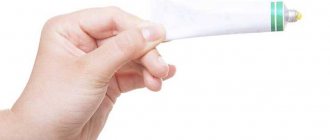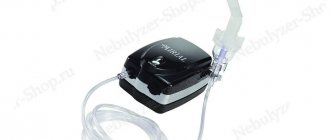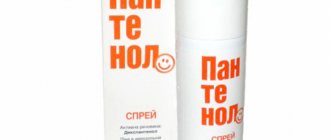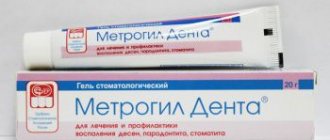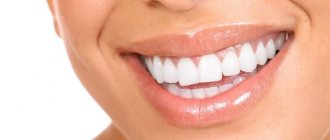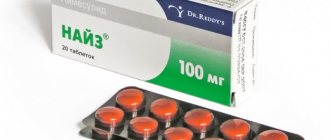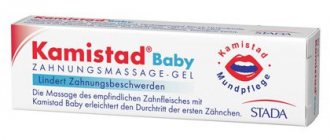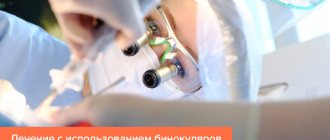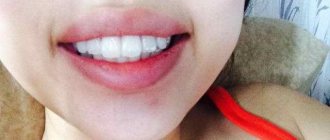Nosological classification (ICD-10)
- A41.9 Septicemia, unspecified
- A49.3 Mycoplasma infection, unspecified
- A59.0 Urogenital trichomoniasis
- A74.9 Chlamydial infection, unspecified
- B00.0 Herpetic eczema
- B00.1 Herpetic vesicular dermatitis
- B18 Chronic viral hepatitis
- B25.9 Cytomegalovirus disease, unspecified
- B34 Viral infection of unspecified localization
- B37.3 Candidiasis of the vulva and vagina (N77.1*)
- G03.9 Meningitis, unspecified
- J06 Acute upper respiratory tract infections of multiple and unspecified localization
- J11 Influenza, virus not identified
- J18 Pneumonia without specifying the pathogen
- N39.0 Urinary tract infection without established location
- N76 Other inflammatory diseases of the vagina and vulva
- O35.3 Fetal injury (suspected) due to maternal viral disease requiring maternal medical attention
- O35.8 Other fetal anomalies and lesions (suspected) requiring maternal medical attention
Types of disease
Based on the nature of the inflammatory elements formed on the mucosa, the following classification is accepted in dentistry:
- Aphthous stomatitis. Areas of inflammation look like oval and round ulcers - aphthae. This clinical form of pathology is divided into types:
- Necrotizing stomatitis. It occurs against the background of severe systemic pathologies. Characterized by the death of cells on the mucous surface in the mouth. Foci of inflammation are painful, on the 3rd-5th day of development of the pathological process they grow, and ulcers appear in their place. Aphthae heal within a month.
- Fibrinous stomatitis. The surface of aphthous ulcers is covered with a gray coating. From the moment of ulceration until the integrity of the mucous membrane is restored, 7-21 days pass. According to statistics, once every 1-3 years there is a relapse of fibrinous stomatitis.
- Scarring. Severe form of stomatitis. It begins with the formation of aphthous inflammations, growing day by day. Soon deep ulcers up to one and a half centimeters in diameter form in their place. Healing takes up to 12 weeks, and scars remain at the site of the ulcers.
- Glandular stomatitis. It affects the salivary glands, which are located throughout the oral cavity. Aphthae form at the exit of the salivary ducts. Painful when pressed.
- Deforming. The most severe variant of the pathology in its manifestations. Ulcers affect large areas of the mucous membrane and heal poorly. After the inflammatory stage, the ulcers heal with the formation of scars and scars that tighten the tissue, causing the oral cavity to become deformed.
- Catarrhal stomatitis is a process of pathology of the upper layers of the oral mucosa. Accompanied by bad breath, swelling and hyperemia of inflammation. The affected mucosal fragments are covered with plaques with a white coating, and tooth imprints remain on the gums and soft tissues of the tongue. There are severe pain, increased salivation, a slight increase in body temperature and weakness.
- Ulcerative gangrenous stomatitis. Severe form: the mucosa is affected by areas of ulceration and necrosis. The inflammatory process can destroy the entire thickness of soft tissue, down to the bone. Accompanied by severe weakness.
Compound
| Ointment for local and external use | 1 g |
| active substance: | |
| interferon human recombinant alpha-2 | 40000 IU |
| excipients: tocopherol acetate - 0.02 g; anhydrous lanolin - 0.34 g; medical petroleum jelly - 0.45 g; peach oil - 0.12 g; purified water - up to 1 g |
| Gel for local and external use | 1 g |
| active substance: | |
| interferon human recombinant alpha-2b | 36000 IU |
| excipients: alpha-tocopherol acetate - 0.055 g; methionine - 0.0012 g; benzoic acid - 0.00128 mg; citric acid monohydrate - 0.001 g; sodium tetraborate decahydrate - 0.0018 mg; sodium chloride - 0.004 g; human serum albumin solution 10% - 0.02 g; distilled glycerin (glycerol) - 0.02 g; carmellose sodium - 0.02 g; ethanol 95% - 0.055 g; purified water - up to 1 g |
| Suppositories for rectal use | 1 sup. |
| active substance: | |
| interferon human recombinant alpha-2b | 150000 IU |
| 500000 IU | |
| 1000000 IU | |
| 3000000 IU | |
| excipients: alpha-tocopherol acetate - 0.055/0.055/0.055/0.055 g; ascorbic acid - 0.0054/0.0081/0.0081/0.0081 g; sodium ascorbate - 0.0108/0.0162/0.0162/0.0162 g; disodium edetate dihydrate - 0.0001/0.0001/0.0001/0.0001 g; polysorbate 80 - 0.0001/0.0001/0.0001/0.0001 g | |
| base: cocoa butter and confectionery fat - up to 1 g |
Sources
The following materials were used in preparing the article:
- Anisimova I.V., Nedoseko V.B., Lomiashvili L.M. Clinic, diagnosis and treatment of diseases of the mucous membrane of the mouth and lips. - M.: 2008. - 194 p.
- Borovsky E.V., Mashkilleyson A.L. Atlas of diseases of the mucous membrane of the oral cavity and lips // Medicine - M.: 2001. - 703 p.
- Langle R. P., Miller K. S. Atlas of oral diseases: Atlas / Translation from English, ed. L. A. Dmitrieva. - M.: GEOTAR-Media, 2008. - 224 p.
- Danilenko S. M. The most common diseases of the oral mucosa // Consilium-Provisorium. - 2001. No. 6. - With. 6.
Pharmacodynamics
Human recombinant interferon alpha-2b has pronounced immunomodulatory, antiviral, antiproliferative properties, suppresses the replication of RNA and DNA viruses.
The complex composition of the drugs (ointment, suppositories, gel) causes a number of new additional effects: in the presence of antioxidants (tocopherol acetate and/or ascorbic acid), the specific antiviral activity of human recombinant alpha-2b interferon increases, its immunomodulatory effect on T- and B-lymphocytes increases , the level of secretory immunoglobulins of class A increases, the level of immunoglobulin E normalizes, and the functioning of the endogenous interferon alpha-2b system is restored. Ascorbic acid and alpha-tocopherol acetate, being highly active antioxidants, have anti-inflammatory, membrane stabilizing, and regenerating properties. The use of the drug VIFERON® as part of complex therapy makes it possible to reduce therapeutic doses of antibacterial and hormonal drugs, as well as reduce the toxic effects of this therapy.
It has been established that when using the drug VIFERON® there are no side effects that occur with parenteral administration of interferon alfa-2b preparations, and no antibodies are formed that neutralize the antiviral activity of interferon alfa-2b.
Causes of stomatitis in adults
According to the etiology, stomatitis in adults occurs:
- traumatic;
- aphthous;
- catarrhal;
- ulcerative;
- candida;
- vesicular;
- bacterial (staphylococcal, streptococcal);
- angular;
- allergic.
Traumatic stomatitis develops as a result of injuries to the oral cavity caused by dentures, chips on tooth enamel, and food. After eliminating the traumatic element, the mucous membrane restores itself. Another reason for this type of pathology is the choice of hot or spicy foods. The result of such eating habits is a burn of the mucous surfaces of the mouth. Its development is provoked by:
- carious cavities with a sharp edge;
- fragments of teeth;
- burns;
- poorly installed crowns, dentures, braces;
- bad habit of biting lips, cheeks, tongue;
- malocclusion, pathological shape of teeth;
- addiction to excessively hot, cold or spicy foods;
- smoking;
- frequent consumption of foods that injure the mucous membrane (nuts, seeds).
The causes of the chronic form of aphthous stomatitis are not fully established. Presumably, the pathology is caused by staphylococci, adenoviruses, autoimmune reactions, and immune disorders.
Specific signs of aphthous stomatitis:
- the oral cavity is strewn with aphthae: round or oval ulcers;
- the center of the ulcer is covered with a gray or yellow coating, the edges are outlined by a narrow area of hyperemia.
Clinical picture of catarrhal stomatitis:
- swelling, hyperemia and painful discomfort of the oral mucosa;
- increased salivation;
- yellowish-white plaques of plaque on the mucous membrane;
- less often - slightly bleeding erosions, foul-smelling breath.
Ulcerative stomatitis occurs as a result of severe catarrhal stomatitis or independently. Sometimes considered a complication of catarrhal disease.
Candidal stomatitis (“thrush”) is a mycotic pathology caused by the hyperactivity of fungi of the genus Candida. Factors conducive to development include:
- immaturity of immunity in infancy;
- deterioration of the body's protective functions due to hematopoietic pathologies, infections, cancer, AIDS;
- old age (there is a natural decline of immune forces);
- hormonal changes during pregnancy;
- neglect of the rules of oral hygiene;
- use of dental prosthetic structures;
- drying out of the mucous membrane;
- pathologies of glucose absorption;
- taking glucocorticoid sprays;
- long-term antibiotic therapy.
Vesicular stomatitis develops as a result of contact with viruses of the genus Vesiculorus, which parasitize the body of cattle. Contamination occurs through the process of mosquito bites. Most often, this type of stomatitis affects veterinarians and farm workers.
Bacterial stomatitis occurs with a pathological increase in the population of bacteria of opportunistic microflora, usually against the background of weakened immunity.
Activation of staphylococcal and streptococcal stomatitis occurs against the background of:
- carious inflammations;
- oral injuries;
- purulent processes in periodontal pockets;
- reduction of local immunity of the oral cavity;
- non-compliance with antiseptic and aseptic rules during surgical and dental treatment.
A type of bacterial stomatitis is angular stomatitis. The cause of the pathology is not only streptococci, but also yeast-like fungi that are part of the symbiotic microflora of the human body.
Allergic stomatitis is a type of pathological autoimmune reaction. Clinical manifestations are polymorphic and include a group of dermatostomatitis, multimorphic exudative erythema and stomatitis of various etiologies (usually catarrhal or aphthous).
Indications for the drug Viferon®
Ointment
viral (including herpetic) lesions of the skin and mucous membranes of various localizations;
treatment of influenza and acute respiratory viral infections in children over 1 year of age.
Gel
in complex therapy of ARVI, incl. influenza, frequent and prolonged acute respiratory viral infections, incl. complicated by bacterial infection;
prevention of acute respiratory viral infections, including influenza;
in complex therapy of recurrent stenotic laryngotracheobronchitis;
prevention of recurrent stenosing laryngotracheobronchitis;
in complex therapy of acute and exacerbations of chronic recurrent herpetic infections of the skin and mucous membranes, incl. urogenital form of herpetic infection;
in complex therapy of herpetic cervicitis.
Suppositories
In complex therapy:
ARVI, including influenza, incl. complicated by bacterial infection, pneumonia (bacterial, viral, chlamydial) in children and adults;
infectious and inflammatory diseases of newborns, incl. premature babies: meningitis (bacterial, viral), sepsis, intrauterine infection (chlamydia, herpes, CMV infection, enterovirus infection, candidiasis, including visceral, mycoplasmosis);
chronic viral hepatitis B, C, D in children and adults, incl. in combination with the use of plasmapheresis and hemosorption for chronic viral hepatitis of pronounced activity, complicated by cirrhosis of the liver;
infectious and inflammatory diseases of the urogenital tract (chlamydia, CMV infection, ureaplasmosis, trichomoniasis, gardnerellosis, papillomavirus infection, bacterial vaginosis, recurrent vaginal candidiasis, mycoplasmosis) in adults;
primary or recurrent herpetic infection of the skin and mucous membranes, localized form, mild to moderate course, incl. urogenital form in adults.
How is stomatitis treated with Viferon?
The medicine for each patient, as well as recommendations for the therapeutic course, are prescribed by the doctor, based on the examination, general condition and age of the patient. Gels and ointments are prescribed for severe pain. These forms are considered the most effective in direct contact with open wounds and are characterized by analgesic properties.
Gels and ointments are easy to treat affected areas and evenly distribute the composition over problem areas.
In dentistry, this pharmaceutical drug is used mainly to eliminate herpetic stomatitis. Many people overlook one important point - inflammation of the epithelium of the mucous membrane can be triggered by bacteria or allergies. In these cases, the use of antiviral drugs (which include Viferon) is fraught with a deterioration in the patient’s well-being.
The therapeutic course can be either systemic or local. Taking this into account, the following forms of medication are prescribed for the treatment of chronic or acute herpetic stomatitis:
- rectal suppositories are the best option for infants and young children;
- ointment - suitable for all patients if the disease is localized on the lips or skin;
- gel is the optimal choice for inflammation of the mucous membrane and mouth ulcers.
The latter form is considered universal because it is suitable for all ages and provides relief from the disease in a few days.
Herpetic stomatitis
Acute stomatitis is treated with antiviral drugs. If we are talking about a chronic form of the disease, then complex therapy is carried out including immunomodulators. Medicines against herpes are produced in the form of gels, creams, ointments and suppositories. Creams and ointments are used for external treatment of inflammation.
Viferon gel for stomatitis is prescribed in cases where we are talking about lesions of the mucous membrane localized in the oral cavity. The main active ingredient of the drug is interferons with pronounced antiviral and immune-stimulating effects, “working” in conjunction with vitamins C and E.
Often, to eliminate the disease, drug treatment is supplemented with lotions and rinses. Many children under the age of 3 have problems with mouth rinsing, so for them, a gel is the best way out of the situation.
Viferon for stomatitis in children
Effective treatment of stomatitis in children involves targeted local exposure and regular rinsing of the mouth. But since a child is often unable to rinse his mouth independently before the age of 3, doctors have to limit themselves to only medicinal components. In such cases, Viferon gel outperforms most ointments for a number of reasons:
- the composition of the gel is characterized by an analgesic effect;
- the medication quickly cleanses the mucous membrane of necrotic tissue;
- the drug actively inhibits pathogenic viral cells;
- activates regeneration of both the mucous membrane and damaged epithelium.
The gel is much preferable to ointment also because it acts directly on the lesions; the course of treatment for herpetic stomatitis ranges from 5 to 10 days. In children, the ointment does not have time to “fix” on the problem area, since it is absorbed extremely slowly, it is often simply licked off by the child. The gel acts directly on the lesions of the mucous membrane, immediately after application.
Use during pregnancy and breastfeeding
Ointment: since when applied externally and locally, the systemic absorption of interferon is low and the drug has an effect only in the lesion, it is possible to use the drug VIFERON® during pregnancy and lactation.
Gel: since the systemic absorption of interferon when applied topically is low and the drug has an effect only in the lesion, it is possible to use the drug VIFERON® during pregnancy and breastfeeding. During lactation, do not use the drug on the area of the nipples and areola.
Suppositories: the drug is approved for use from the 14th week of pregnancy. There are no restrictions for use during lactation.
Estimated cost of the drug VIFERON Ointment in pharmacies
According to aptekamos.ru, the price of the drug VIFERON Ointment for external and local use, 40,000 IU/g 12 g tube, in pharmacies ranges from 104 to 233 rubles. The cost of the drug is given as of July 2022.
Specialist comments: Dmitry Aleksandrovich Belyaev, General Practitioner
* The prodromal period is the period of the disease that occurs between the incubation period and the beginning of the active development of the disease.
1 Kurbanova Kh.I., Zakharova I.N., Malinovskaya V.V., Korovina N.A. (candidate of medical sciences) “Efficacy and tolerability of intranasal use of the drug Viferon® for ARVI in children”, “EFFECTIVE PHARMACOTHERAPY. Pediatrics” No. 5 2 Z. S. Makarova, V. A. Doskin, V. V. Malinovskaya, V. V. Parfenov “Use of Viferon, ointment for the prevention of acute respiratory viral infections in children”, Children’s infections No. 1, 2007 3 A.A. . Khaldin, O.V. Chistik, D.V. Ignatiev “Herpes simplex: etiology, pathogenesis, diagnosis, treatment”, Practical Medicine No. 5, 2009
Side effects
Ointment: in most cases, VIFERON® is well tolerated. When applied to the nasal mucosa, side effects are weak and transient and disappear on their own after discontinuation of the drug.
Gel: in extremely rare cases, a local allergic reaction may occur in some highly sensitive individuals. In such cases, stop using the drug.
Suppositories: in rare cases - allergic reactions (skin rashes, itching). These phenomena are reversible and disappear 72 hours after stopping the drug.
The difference between the drug VIFERON Ointment and the drug VIFERON Gel: which is better
| • | The similarity between gel and ointment is that they are products for external use and are intended for application to the surface of the skin and mucous membranes. |
| • | Differences: the gel has a soft and viscous consistency of a hydrophilic water-based product that does not contain fats and oils, so it quickly manifests its properties on the mucous membranes. And VIFERON Ointment is created on a fatty (hydrophobic) basis containing petroleum jelly and lanolin, so it is easily absorbed into the skin. |
| • | To the question “Which is better?” there is no clear answer. Both gel and ointment have their advantages. |
Directions for use and doses
Ointment, externally and locally. For herpes infection, apply a thin layer of ointment to the affected areas 3-4 times a day and rub in gently. Duration of treatment is 5–7 days. It is recommended to begin treatment immediately when the first signs of damage to the skin and mucous membranes appear (itching, burning, redness). When treating recurrent herpes, it is advisable to begin treatment in the prodromal period or at the very beginning of the appearance of signs of relapse.
To treat influenza and other acute respiratory viral infections, the ointment is applied in a thin layer to the mucous membrane of the nasal passages 3-4 times a day throughout the entire period of the disease.
Children from 1 year to 2 years - 2500 IU (1 pea with a diameter of 0.5 cm) 3 times a day; from 2 to 12 years - 2500 IU (1 pea with a diameter of 0.5 cm) 4 times a day; from 12 to 18 years - 5000 IU (1 pea with a diameter of 1 cm) 4 times a day. The duration of treatment is 5 days.
Gel, externally and locally.
In the complex therapy of ARVI, including influenza, long-term and frequent ARVI, incl. complicated by a bacterial infection: a strip of gel no more than 0.5 cm long is applied to the previously dried surface of the nasal mucosa and/or to the surface of the tonsils 3-5 times a day using a spatula or a cotton swab/cotton swab (see Note). The course of treatment is 5 days; if necessary, the course can be extended.
Prevention of ARVI, including influenza: during the period of rising incidence, a strip of gel no more than 0.5 cm long is applied to the previously dried surface of the nasal mucosa and/or to the surface of the tonsils 2 times a day for 2–4 weeks.
In complex therapy of recurrent stenosing laryngotracheobronchitis: a strip of gel no more than 0.5 cm long is applied to the surface of the palatine tonsils using a spatula or a cotton swab/cotton swab in the acute period of the disease 5 times a day, for 5–7 days, then 3 times a day day for the next 3 weeks.
Prevention of recurrent stenosing laryngotracheobronchitis: a strip of gel no more than 0.5 cm long is applied to the surface of the tonsils using a spatula or a cotton swab/cotton swab 2 times a day for 3-4 weeks, courses are repeated 2 times a year.
In complex therapy of acute and chronic recurrent herpetic infection (at the first signs of the disease or during the period of warning signs): a strip of gel no more than 0.5 cm long is applied using a spatula or a cotton swab/cotton swab to a previously dried affected surface 3–5 times per day. day for 5–6 days, if necessary, the duration of the course is increased until clinical manifestations disappear.
In complex therapy of herpetic cervicitis: 1 ml of gel is applied with a cotton swab to the surface of the cervix, previously cleared of mucus, 2 times a day for 7 days; if necessary, the duration of the course can be increased to 14 days.
Note. The gel is applied to the mucous membrane of the nasal cavity after cleansing the nasal passages, and to the surface of the palatine tonsils - 30 minutes after eating. When applying the gel to the tonsils, do not touch the tonsils with a cotton swab, but only with the gel; the gel flows down on its own along the surface of the tonsil. When applying the gel to the cervix, you should first remove mucus and discharge from the vaginal vaults and cervix with a cotton or gauze swab.
When applying the gel to the affected areas of the skin and mucous membranes, after 30–40 minutes a thin film is formed, onto which the drug is again applied. If desired, the film can be peeled off or washed off with water before reapplying the drug.
Suppositories, rectally.
1 suppository contains human recombinant interferon alpha-2b as an active substance in the indicated dosages (150,000 IU, 500,000 IU, 1,000,000 IU, 3,000,000 IU).
Acute respiratory viral infections, including influenza, incl. complicated by bacterial infection, pneumonia (bacterial, viral, chlamydial) in children and adults as part of complex therapy. Recommended dose for adults, including pregnant women and children over 7 years old VIFERON® 500,000 IU, 1 suppository 2 times a day after 12 hours every day for 5 days. According to clinical indications, therapy can be continued.
Children under 7 years old, incl. For newborns and premature infants with a gestational age of more than 34 weeks, it is recommended to use the drug VIFERON® 150,000 IU, 1 suppository 2 times a day after 12 hours every day for 5 days. According to clinical indications, therapy can be continued. The break between courses is 5 days.
Premature newborns with a gestational age of less than 34 weeks are recommended to use the drug VIFERON® 150,000 IU, 1 suppository 3 times a day after 8 hours every day for 5 days. According to clinical indications, therapy can be continued. The break between courses is 5 days.
Infectious and inflammatory diseases of newborns, incl. premature babies: meningitis (bacterial, viral), sepsis, intrauterine infection (chlamydia, herpes, CMV infection, enterovirus infection, candidiasis, including visceral, mycoplasmosis) as part of complex therapy. Recommended dose for newborns, incl. premature babies with a gestational age of more than 34 weeks VIFERON® 150,000 IU daily, 1 suppository 2 times a day after 12 hours. The course of treatment is 5 days.
Premature newborns with a gestational age of less than 34 weeks are recommended to use the drug VIFERON® 150,000 IU daily, 1 suppository 3 times a day after 8 hours. The course of treatment is 5 days.
Recommended number of courses for various infectious and inflammatory diseases: sepsis - 2-3 courses, meningitis - 1-2 courses, herpes infection - 2 courses, enterovirus infection - 1-2 courses, CMV infection - 2-3 courses, mycoplasmosis, candidiasis , including visceral - 2-3 courses. The break between courses is 5 days. According to clinical indications, therapy can be continued.
Chronic viral hepatitis B, C, D in children and adults as part of complex therapy, incl. in combination with the use of plasmapheresis and hemosorption for chronic viral hepatitis of pronounced activity, complicated by cirrhosis of the liver. The recommended dose for adults is VIFERON® 3,000,000 IU, 1 suppository 2 times a day every 12 hours every day for 10 days, then 3 times a week every other day for 6–12 months. The duration of treatment is determined by clinical effectiveness and laboratory parameters.
For children under 6 months of age, 300,000–500,000 IU per day is recommended; at the age of 6 to 12 months - 500,000 IU per day.
For children aged 1 to 7 years, 3,000,000 IU per 1 m2 of body surface area per day is recommended.
For children over 7 years old, 5,000,000 IU per 1 m2 of body surface area per day is recommended.
The drug is used 2 times a day every 12 hours for the first 10 days, then 3 times a week every other day for 6–12 months. The duration of treatment is determined by clinical effectiveness and laboratory parameters.
The daily dose of the drug for each patient is calculated by multiplying the recommended dose for a given age by the body surface area calculated using the nomogram for calculating body surface area by height and weight according to Garford, Terry and Rourke. The calculation of a single dose is carried out by dividing the calculated daily dose into 2 administrations, the resulting value is rounded up to the dosage of the suppository.
In case of chronic viral hepatitis of pronounced activity and liver cirrhosis, before plasmapheresis and/or hemosorption, it is recommended to use VIFERON® 150,000 IU for children under 7 years of age, VIFERON® 500,000 IU for children over 7 years of age, 1 suppository 2 times a day every 12 hours. within 14 days.
Infectious and inflammatory diseases of the urogenital tract (chlamydia, CMV infection, ureaplasmosis, trichomoniasis, gardnerellosis, papillomavirus infection, bacterial vaginosis, recurrent vaginal candidiasis, mycoplasmosis) in adults, including pregnant women as part of complex therapy. The recommended dose for adults is VIFERON® 500,000 IU, 1 suppository 2 times a day after 12 hours every day for 5–10 days. According to clinical indications, therapy can be continued.
Pregnant women from the second trimester of pregnancy (starting from 14 weeks of gestation) are recommended VIFERON® 500,000 IU, 1 suppository 2 times a day every 12 hours for 10 days, then 3 times for 9 days with an interval of 3 days (on the 4th day) 1 suppository 2 times a day after 12 hours. Then every 4 weeks until delivery VIFERON® 150,000 IU, 1 suppository 2 times a day after 12 hours every day for 5 days. If necessary, it is indicated before delivery (from 38 weeks of gestation) VIFERON® 500,000 IU, 1 suppository 2 times a day after 12 hours every day for 10 days.
Primary or recurrent herpetic infection of the skin and mucous membranes, localized form, mild to moderate course, incl. urogenital form in adults, including pregnant women. The recommended dose for adults is VIFERON® 1,000,000 IU, 1 suppository 2 times a day after 12 hours every day for 10 days or more for recurrent infections. According to clinical indications, therapy can be continued. It is recommended to begin treatment immediately when the first signs of damage to the skin and mucous membranes appear (itching, burning, redness). When treating recurrent herpes, it is advisable to begin treatment in the prodromal period or at the very beginning of signs of relapse.
Pregnant women from the second trimester of pregnancy (starting from 14 weeks of gestation) are recommended VIFERON® 500,000 IU, 1 suppository 2 times a day every 12 hours for 10 days, then 3 times for 9 days with an interval of 3 days (on the 4th day) 1 suppository 2 times a day after 12 hours. Then every 4 weeks until delivery VIFERON® 150,000 IU, 1 suppository 2 times a day after 12 hours every day for 5 days. If necessary, it is indicated before delivery (from 38 weeks of gestation) VIFERON® 500,000 IU, 1 suppository 2 times a day after 12 hours every day for 10 days.
Instructions for use
The medicine in suppositories is used rectally (the suppository is inserted into the anus). To insert suppositories correctly, you need to spread your buttocks and insert a suppository into the anus. After administering the medicine, you should lie down for half an hour. During this time the candle will dissolve.
Now we will tell you how to place a Viferon suppository rectally for a baby. For children, suppositories are administered in a position on their side (newborns) or on their stomach (children over 1 year). To administer the medication, spread the buttocks and insert a suppository into the anus. Next, squeeze the gluteal muscles and hold the child in this position for 2-3 minutes (since the candle may slip out). After administering the drug, the baby should lie down for half an hour.
